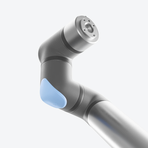Evolving market and customer demands mean that the vehicle of the future is changing. Automakers are adapting to the need for more diverse offerings and leaner production workflows. In addition, the EV market is set to expand by 16% while YoY growth for Hybrid vehicles is predicted to grow as much as 23% in 2025, adding production complexity.
This means that OEMs and car manufacturers must increasingly deal with reduced product life cycles and a vast, unprecedented increase in data volumes.
And they must become more digitally enabled to drive agility and unlock greater productivity aligned to increased speed.
All while growing at scale and accelerating innovation everywhere. To do this, they require increased control and visibility into performance at every level of production.
Five key ways cobots are unleashing operational productivity
To solve these challenges, OEMs and auto manufacturers are choosing collaborative robots to gain complete transparency across all operational data, use cases and reusable programs.
Cobots are enhancing productivity in critical ways to drive performance and unlock value across every area of manufacturing production. Here’s how:
#1: Cobots are driving increased productivity and operational speed
By empowering engineers through intelligent collaboration, cobots are maximizing human cognitive skills while accelerating productivity through automation.
They support superior higher levels of accuracy and can undertake tedious, manually intensive tasks to free up resources and improve productivity in component handling by 30%.
#2: Collaborative robots handle dangerous tasks
Collaborative robots can do highly physically demanding and unsafe jobs to protect human workers from risk and injury. They help make the production floor safer while freeing up skilled workers to focus on higher-value tasks.
#3: Cobots drive increased agility, command and control of operations
The automotive market faces huge volatility and uncertainty as we shift toward a more data-driven, tech-enabled future powered by 4IR capabilities. Deploying collaborative robots allows manufacturers to collect and analyze huge volumes of data, reducing downtime and supporting informed production decisions. They can be deployed quickly and reprogrammed, customized and reprogrammed easily to deliver to evolving market and customer demands. Their increased flexibility means reduced production cycles and faster time to market.




